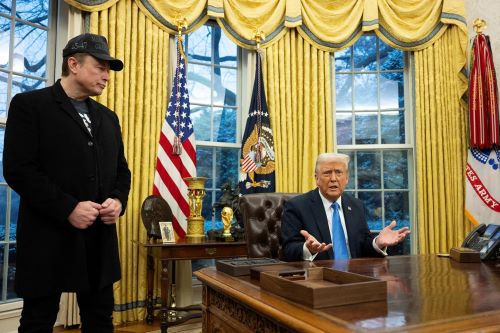

The real question is whether DOGE will be reformed from within, dismantled altogether, or quietly absorbed into another branch of the administrative apparatus.

By Matthew A. McIntosh
Public Historian
Brewminate
A Name That Promised Reform
When the Department of Government Efficiency, DOGE for short, was launched with great fanfare in January 2025, it was sold to the public as a bold attempt to rein in waste, modernize federal operations, and restore public trust in how government works. It was also politically convenient. At a time of mounting national debt and eroding confidence in bureaucratic institutions, DOGE offered the illusion of action.
The name alone carried a kind of marketing brilliance. “Efficiency” is difficult to argue against. It speaks to restraint, competence, and streamlined service. Republican Congressional leaders applauded the initiative, with many touting it as an overdue move toward fiscal sobriety. The department was granted emergency startup funding with a mandate to audit, consolidate, and optimize redundant federal services.
Now, less than two years into its operations, DOGE has burned through more than half that budget. A recently leaked Inspector General report shows $21.7 billion spent in the last six months alone. The irony, barely disguised, is that a department created to save money has quickly become one of the most opaque and expensive in modern federal history.
Where Did the Money Go?
Tracing the flow of DOGE’s expenditures is not easy. Public reporting requirements were waived in part due to the department’s experimental status. It was categorized as a “hybrid task force” with both executive and administrative privileges, which granted it unusual discretion in spending. Even now, the White House Office of Management and Budget has only released skeletal summaries of where the funds have gone.
Some of the spending appears legitimate. DOGE launched several pilot programs in digital infrastructure, including attempts to centralize outdated data management systems across dozens of federal agencies. It also spearheaded a plan to modernize procurement software in defense contracting, a move that many experts have long supported.
But other spending lines raise sharper questions. Tens of millions went to outside consultants, some of them with direct ties to DOGE’s leadership. A $600 million initiative to automate interdepartmental communication has failed to reach even the prototype stage, hampered by software glitches and interagency resistance.
A $1.2 billion subcontract for “civic identity consolidation” reportedly funded a biometric database that was scrapped after legal challenges. Several billion more were funneled into real estate leases and office overhauls, despite DOGE’s original promise to operate as a lean, largely remote operation.
Bureaucracy by Another Name

Critics argue that DOGE was flawed from the outset. In attempting to impose top-down reforms on a bureaucracy as vast and entrenched as the U.S. federal government, it assumed a level of agility that simply did not exist. Efficiency, they argue, cannot be legislated into being by creating yet another department.
DOGE wasn’t cutting any actual waste, but employment was absolutely a casualty in a push end government oversight and turn everything over to the private sector. Jim Powers writes for East Texas News, “And make no mistake: privatization is rushing in to fill the vacuum. Many of the functions once handled by federal workers are now being outsourced to private contractors, some with direct financial ties to Musk’s own ventures.”
Indeed, many of DOGE’s initiatives appear to have collided with the very silos it was meant to dissolve. Agencies resisted audits. Interdepartmental turf wars stalled integration plans. Several high-level resignations over the past year have not been fully explained, but internal memos suggest disagreements over the department’s expanding scope and lack of oversight.
What began as a small reform body now employs people drawn from private-sector contracting firms and temporary task forces. The department leases space in three major cities and operates out of a custom-renovated building in Washington once intended for use by the Department of Housing and Urban Development.
Political Theater and the Illusion of Reform
The emergence of DOGE was politically opportune. It allowed leaders in both parties to gesture toward reform without confronting the structural challenges of accountability, redundancy, and interagency dysfunction. The fact that the department was intentionally branded with a sleek acronym only added to its appeal.
For months, DOGE was cited in press briefings as evidence that Washington was finally “taking waste seriously.” Meanwhile, few in Congress requested detailed performance reviews. The bipartisan approval that once shielded the department is now beginning to crack.
It took some time and some political wrangling, but DOGE’s “auditors” are now finally being audited themselves by the Government Accountability Office (GAO). DOGE itself is nothing more than another ponzi scheme operated by the greatest grifters in modern history.
Yet many members remain quiet, wary of challenging a program they previously supported. Some continue to defend the spending, arguing that any attempt to streamline federal systems will face resistance and incur high startup costs. The problem, they say, is not mismanagement but underestimation of the scale.
A Broader Reckoning
What the DOGE episode reveals may be less about the specifics of one department and more about the deeper habits of Washington. Reform efforts tend to fall into two camps: those that chip away at inefficiencies over time, and those that promise transformation in a single sweep. The latter often fail not for lack of vision, but because of their refusal to contend with the messy realities of governance.
DOGE was sold as a revolution. Instead, it has become a cautionary tale.
The $21.7 billion in spending may eventually yield some improvements in agency systems, if current programs survive and evolve. But for now, the public sees little evidence of progress. For a department that promised transparency, its opacity has become its defining feature.
In the coming months, watchdog groups and fiscal conservatives will likely escalate demands for accountability. The real question is whether DOGE will be reformed from within, dismantled altogether, or quietly absorbed into another branch of the administrative apparatus, leaving behind a few renamed initiatives and a particularly expensive lesson in the perils of rebranding dysfunction. In the end, the Department of Government Efficiency may not have reduced waste, but it has certainly redefined it.
Originally published by Brewminate, 08.05.2025, under the terms of a Creative Commons Attribution-NonCommercial-NoDerivatives 4.0 International license.


